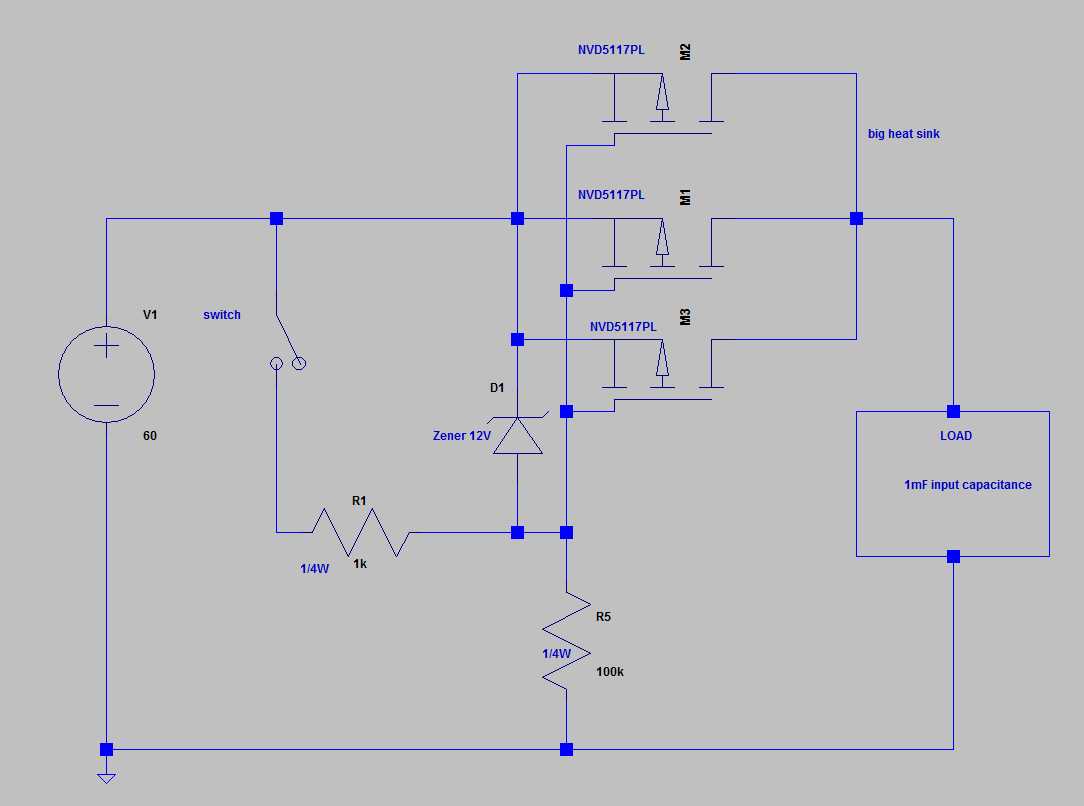Post History
Answer to question 1: First, you need p-mos and not n-mos, as you are switching the circuit from the above. Second, it is better and simpler to parallelize mosfets for big current switches; this w...
#2: Post edited
- **Answer to question 1:** First, you need p-mos and not n-mos, as you are switching the circuit from the above.
- Second, it is better and simpler to parallelize mosfets for big current switches; this will reduce the power dissipation as well.
- So, even if there exist a pmos with 150A ability (which I'm not sure), it is probably better and less expensive to parallelize 3 p-mos (say) of 60A. The NVD5117PL 60V, 60A, is an option.
- Here is the schematic:
- 
- **Answer to question 2:**
- There is apparently no problem with your second approach, but we don't know the whole story: is there anything else connected to the battery? we need to know the whole circuitry to answer to this question.
- Also, you may connect the ground after the mosfet switch, if the battery is floating. Finally, are you sure you know how to connect mosfets in series to distribute the power? this is not as trivial as parallelizing them for a switch!
- *Note:* Again, I would implement 2 or 3 n-mos in parallel, in place of 2 n-mos in series.
- **Answer to question 1:** First, you need p-mos and not n-mos, as you are switching the circuit from the above.
- Second, it is better and simpler to parallelize mosfets for big current switches; this will reduce the power dissipation as well.
- So, even if there exist a pmos with 150A ability (which I'm not sure), it is probably better and less expensive to parallelize 3 p-mos (say) of 60A. The NVD5117PL 60V, 60A, is an option.
- Here is the schematic:
- 
- And here is a solution if you have to control the switch from below:
- 
- **Answer to question 2:**
- There is apparently no problem with your second approach, but we don't know the whole story: is there anything else connected to the battery? we need to know the whole circuitry to answer to this question.
- Also, you may connect the ground after the mosfet switch, if the battery is floating. Finally, are you sure you know how to connect mosfets in series to distribute the power? this is not as trivial as parallelizing them for a switch!
- *Note:* Again, I would implement 2 or 3 n-mos in parallel, in place of 2 n-mos in series.
#1: Initial revision
**Answer to question 1:** First, you need p-mos and not n-mos, as you are switching the circuit from the above. Second, it is better and simpler to parallelize mosfets for big current switches; this will reduce the power dissipation as well. So, even if there exist a pmos with 150A ability (which I'm not sure), it is probably better and less expensive to parallelize 3 p-mos (say) of 60A. The NVD5117PL 60V, 60A, is an option. Here is the schematic:  **Answer to question 2:** There is apparently no problem with your second approach, but we don't know the whole story: is there anything else connected to the battery? we need to know the whole circuitry to answer to this question. Also, you may connect the ground after the mosfet switch, if the battery is floating. Finally, are you sure you know how to connect mosfets in series to distribute the power? this is not as trivial as parallelizing them for a switch! *Note:* Again, I would implement 2 or 3 n-mos in parallel, in place of 2 n-mos in series.


















